
A Comprehensive Interpretation of China’s New Development Pattern
The Proposal urges the country to accelerate the establishment of a dual circulation development pattern in which domestic grand cycle plays a leading role while international cycle remains its extension and supplement.
The Fifth Plenary Session of the 19th Communist Party of China (CPC) Central Committee was held in Beijing from October 26 to 29, 2020. The session deliberated on and approved the Central Committee’s Proposals for Formulating the 14th Five-Year Plan (2021-2025) for National Economic and Social Development and Long-Term Objectives Through the Year 2035. The Proposal urges the country to accelerate the establishment of a “dual circulation” development pattern in which the domestic grand cycle plays a leading role while the international cycle remains its extension and supplement. The connotation of this new development pattern is extremely rich, whose core principles and basic requirements can be explained in three aspects.
Not limited to economy
First, the domestic grand cycle is more than the economic aspect,also involves technical,safety and regional perspectives. From the economic perspective, the domestic grand cycle refers to social reproduction process, consisting of an endless cycle of production, distribution, circulation and consumption. In reality, these four steps almost happen at the same time and influence each other. For example, production activities generate output, which will be transferred into the income of households, firms and government according to its distribution mode. Through circulation, the economic entities consume their incomes and stimulate production. Under the condition of the market economy, the domestic grand cycle is a combination of material circulation and value circulation. The cycling of commodity and service matches the flow of monetary capital when it is re-distributed in the process of social reproduction.
From the technical perspective, the domestic grand cycle requests China to strengthen innovative capabilities, make breakthroughs in a number of core and key technologies and achieve the status of technology self-reliance. Xi Jinping highlighted this problem as a strategic major issue which is related to China’s overall development and the key of formulating a grand domestic cycle. Recently, China is subject to the US ban or restriction in the field of high-tech R&D cooperation and product technical service import while ZTE, Huawei and Byte Dance are being sanctioned. So, it seems impossible to depend on external sources for core technology. Instead of getting stuck in such a weak position, we must determine to find out ways towards technical solutions.
According to national security,the grand domestic cycle requires a stable and reliable value and supply chain. Under the condition of economic globalization, international production coordination is necessary but the weaknesses are fairly obvious. For example, it can be easily affected by geopolitical tensions or extreme events. Covid-19 results in a huge impact on the global industrial supply chain, especially for the risk-exposed and foreign-dependent resources and services. In order to strengthen the stability of industrial supply chain and protect industry security, we should prioritize upgrading domestic industrial chain development by strengthening, remedying and consolidating.
From the regional perspective, the grand domestic cycle demands building up a high-standard market system, eliminating region segmentation and erasing regional protection so as to form a unified domestic market. According to comparative advantage theory, every region should develop local advantages referring to their resource endowments rather than overlapping construction or excessive competition. On one hand, countries are supposed to use financial or fiscal policies as the important tools of macroeconomic adjustment so that they can balance the regional profits and break down segmentation or protectionism. On the other hand, the profits of the industry which located on the upper side of vertical specialization systems should be protected.
As we can see from these four perspectives, the core essence of “Domestic Grand Cycle” is that economic growth mainly depends on domestic demands, based on market forces with the government playing an important role.

Opening-up will continue
Secondly, the leading role of the grand domestic cycle is not equal to a closed economy. The experience of more than 40-years of reform and opening-up shows that the development of the domestic market can’t separate from the resources of international markets. The international cycle not only covers the shortage of China’s production factors structural problem but also helps provide a smooth foundation for domestic industry operation. Instead of losing significance, it is the international cycle that boosts the domestic one. China is supposed to make good use of its huge market to expand imports, raise the quality and efficiency in using foreign investment and strengthen scientific and technological openness or exchanges. At the same time, China should improve the quality of domestic supply and realize the balance between supply and demand.
The international circulation can not be separated from Chinese market. China can serve as an important engine for world economic growth and prosperity. The World Bank estimates that China contributes about 33.9 percent of the world GDP growth between 2009-2019 and occupies the first place in the world, which is 8.5 percent more than the second one, US China’s economic and social development creates a great deal of demands for the world. Commodity and service import continues expanding, especially that service import has reached a record of $501.4 billion in 2019, accounting for 8.7 percent of the world and ranking second in the world after the US. Tourist industry accounts for over half of the service import while intellectual property fee takes up almost 7 percent. China’s economic and social development also creates a huge market for multinational cooperations.
In 2010-2019, the profits of Chinese foreign-invested industrial enterprises amounts to 10.2 trillion yuan, with an annual average profit of more than 1 trillion yuan. The expansion of China’s foreign direct investment stimulates the development of the host country. In 2019, China’s FDI is 136.91 billion dollars, while its flow accounts for 10.4 percent of the world and ranks the second place and its stock ranks third with a proportion of 6.4 percent.
International experience shows that the prosperity of a big economy relies on international markets instead of domestic market alone. Although protectionism and unilateralism arise, economic globalization is an objective process of world economic development. It is a great historical trend that is independent of man’s will. Since the 1950s, the United States, Germany and Japan show up the features of export-oriented. Especially in Germany, its dependency on foreign trade increase up top 90 percent currently. These three countries’ export represents about 21 percent of the world market, with 10 percent (the US), 7.5 percent (Germany) and 3.5 percent (Japan) respectively. These facts show that even for the domestic demand driving economies, they can not survive without the international cycle.
Dual circulation is a complementary pattern
Thirdly, the domestic and international cycle is a complementary whole that can reinforce each other. Both of them are indispensable. On one hand, we should focus on breaking through the barriers in the cycle of production, distribution, current and consumption to strengthen the domestic market. The improvement of grand domestic cycle facilitates the international one. On the other hand, it is important to connect the international and domestic market well and make better use of these two markets and resources, which may help promote the domestic grand cycle.
In a nutshell, we should treat “meeting domestic demands” as the starting point and destination of development while accelerating to construct a complete domestic demand system. We should establish “enhancing the capability of independent innovation” as the main direction of our future work. Supported by high-standard opening up, we are supposed to cultivate China’s new advantage among the brand-new international coordination and competition.
Xu Peng is research fellow at Chinese Academy Macroeconomic Research.
 Facebook
Facebook
 Twitter
Twitter
 Linkedin
Linkedin
 Google +
Google +










